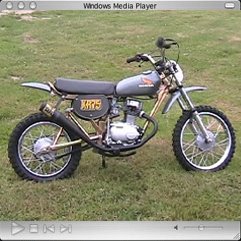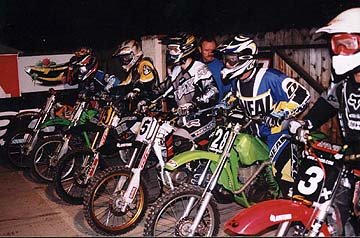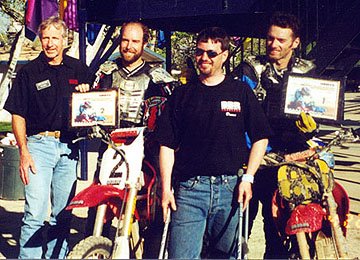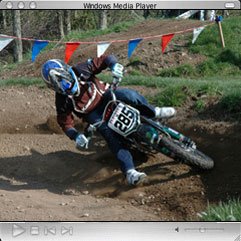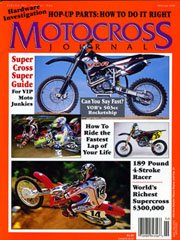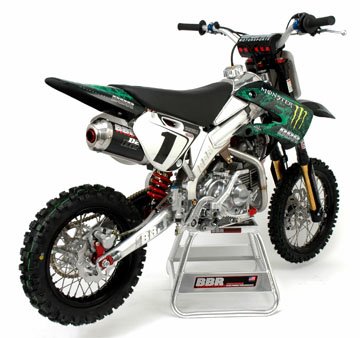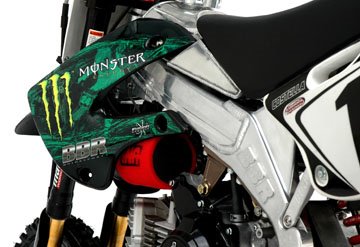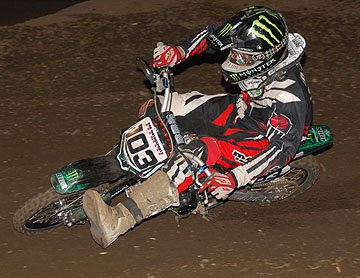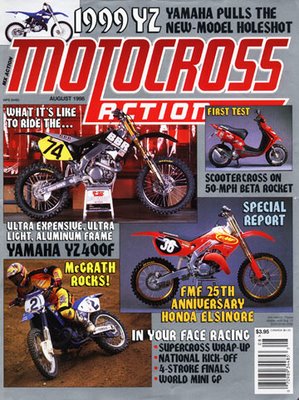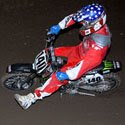Building Championship Winning Bikes
First, let’s take a look at the rules that govern Derek’s bikes. In 2003, Tim Clark gave us a call and said he was thinking of putting a race on in Las Vegas. We were stoked at the idea of an adult playbike race. Larry Kuebler (our Sales Manager) and I jumped on a plane to get face to face with Tim and check out the arena. Once the Orleans Arena was decided on, we had to come up with the rules for the first MiniMoto SX. The 50 and 110 classes were still in their infancy and there weren’t many after market race parts available for these two bikes. Our thought was to set a wheel size, wheel base limit, and require them to be air cooled. This would allow manufacturers room to develop frames and motor parts with out too much restriction. It would also keep it simple for the racers and spectators to understand. I personally wanted to make the 50s use a 10 inch front wheel (to keep them small and hard to ride) plus use a short wheel base. We also discussed a no "4-valve head" rule due to cost - but both of these were shot down. Enough people were already using them so it would have been hard to go back. The rules have pretty much stayed the same since that first MiniMoto and have become industry standard – except for one – the fifty wheel base. It grew by two inches from 44 to 46. I opposed this change because, all of a sudden, you could take a 110 and put 50 wheels on it and race the 50 class. The 150 class had already been dropped and now the 50 class was morphing into the 110 class. Why not allow water cooling, cradles, and bigger wheels too? Shoot, let’s just race 450s! Oh wait; there’s already a series for those…
With the current rules in place we decided to increase the BBR 50 wheelbase right to the new limit. We also tested a 50 wheeled 110 just to make sure it wasn’t the way to go. The frame on the perimeter 50 was stretched and the footpegs were moved back. This gave the bike a roomier feel plus it put more weight on the front wheel helping to get rid of the front end push that 50s are so famous for. Different fork and shock lengths were tried until the perfect balance was achieved. The next step in chassis setup was tires. We knew we had to go bigger. The motors had become more powerful than any 50 chassis or 10 inch wheel could ever handle. It was obvious that if we were going to keep from spinning the tiny rear wheel and pushing the front tire we were going to have to go huge in the tire department. We went with 3.50x10 in the rear and 2.75x12 in the front. Problem solved. The next step to building the ultimate 50 was to smooth the engine out. If you are spinning the tire you are not going forward. Plus the harder the power comes on the worse the bike handles. Picture how good a stock 2.7 H.P. Honda 50 handles. The stock Honda 50 is so slow it doesn’t push the front tire, wheelie out of the corners, or spin the back tire. That is why it is so fun to ride. Now picture putting a 20 H.P. motor into that same stock bike. It would be a nightmare to hang onto and the suspension wouldn’t even know what to do. The trick is to come up with a power spread that keeps you moving forward and not fighting the bike. This is why the CRF450R has been so successful over the years. Some people confuse smoothness for slow, but as Jeanie Carmichael once told us, “the stopwatch doesn’t lie”.
The actual motor we use in the 50 is the Daytona dual over head cam 4-valved setup. It has proven to be a very reliable race engine - plus they are quality Japanese parts you can count on. We do our own porting to move the power curve to fit each rider. We also use flywheel weights and different carb sizes all to personalize the power curve. I did test some of the Chinese 50 engines to see what they were all about. They use a Honda 50 style bottom end with a 110 style top - but no two of them are the same. By the time you get them going fast enough to win they aren’t that much cheaper than building a real motor. Plus, when the clutch basket comes flying out the side of the cases, most riders don’t think that is as funny as I do. Daytona is working on a complete race motor in a box that is going to be priced right and make MX power right out of the box. I have been testing one all summer and, for a production motor, it is awesome. It will definitely change everything. It should be available before Christmas (watch our website). You can check out the Daytona factory here:
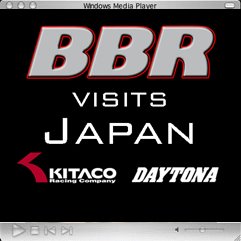
Once we had the 50 frame, suspension, and engine up to speed it was time to start spinning laps. The BBR test track is at my house so it makes it easy to ride as much as possible and let’s face it, isn’t that why we are all doing this? I have a great bunch of riders that come over on a regular basis so we can get some real feedback quickly. Everyone from pros, kids, neighbors, and even the secretary, all give input on BBR bikes and parts.
Once the in-house testing is complete we call in the big guns to check our work. We flew Timmy Weigand up (Honda test rider and factory Honda WORCS racer) to spin laps on the 50 to get his input. Right from the start he loved the 50. The sketchy handling was gone and the motor was smoothed out. A simple fork revalve and a shock spring swap and he was ready to go. Timmy even strung together one of the biggest double jump combos I have ever seen on a 50. Unfortunately, we didn’t get that on video, but we did get this: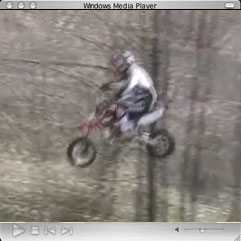
Next up was Derek. Derek is the fastest mini-bike rider in the world. I’ve been lucky enough to ride with everyone from MC to RC and RV. Derek can throw it down and finds speed where there is none. The best part is that no one has more fun riding minis than Derek. He always has a huge smile under his helmet.
Derek flew up from Vegas to test the new bikes. Since I am personally responsible for global warming (I think there’s a hole in the ozone above my house!) it decided to snow in April. Who cares - we rode anyway and you can check out the video here (also some testing in Las Vegas at start of video):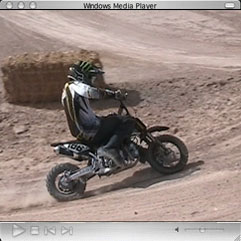
To avoid destroying the bikes in the mud, we decided to ship them to Vegas and test at Derek’s home track. At first Derek thought he wanted to race the 50 class on a 110 with 50 wheels because of the huge power the 110 makes. But in the end, the stop watch prevailed and he was faster on the 50. The other problem with the 110/50 combo is ground clearance. There is none. Saw a lot of guys on this combo struggling to get through the whoops at MiniMoto. If you are dragging the skidplate around the track it isn’t going to work. After a few tweaks to the brakes, to make them like a light switch (like Derek wants), new fork springs, and a header swap was all Derek needed to run away from the best riders in the world at MiniMoto in the 50 class.
With the 50 dialed in, it was time to concentrate on the 110. The engineers at Kitaco emailed us in December (2007) and said they were working on a 4-valved 110 head they wanted us to try. It would be a brand new design (not based on any other motor). At first we were hesitant because we already had the 110 dialed with the perfect MX style of power. I had tested all of the big stroker engines and short piston setups, but most were a mess: All they did was make lots of noise and a lot of wheel spin. Since testing is what we love to do we decided to find out what the 4-valve was all about. Brent, Kurt, and I jumped on a plane and flew over to Kitaco in Japan. When we got there we were surprised to find out we were the first American distributor to ever visit them in Japan. We hooked up with their head engineer, who designs and engineers all of Kitaco’s engine parts. He showed us the very first 4-valved head and let us take one for a spin in the parking lot. It definitely made big power, but was it the right kind of power to win? We would find out shortly. The employees at Kitaco, told us they wanted to fly to Las Vegas to watch the 4-valved head win. That is why they contacted us. We laughed and told them that it’s not that easy. There is a huge luck factor that can play out at anytime. But they insisted. We got back to the states and the testing began. Right out of the box the production Kitaco 160 4-valve top end was dyno testing the same as our full race motor from one year earlier. The power curve was a little lower because it is basically a stroked to 143 motor (up to 160cc). No problem. We developed a slightly larger D2 exhaust (that now comes standard with the V3 frame)and ported the head to flow a bit higher to let the bike "over-rev". What we ended up with is a race motor making two more horsepower than we previously had made, while still keeping the same magic power curve. Plus it was cheaper and easier to build in the long run. At first, Derek wasn’t sure about the new motor. He likes the bike to steer on a dime and anytime you add more power it messes with the handling. But once he had some time riding the new motor against the old motor, he realized he could shift up a gear in the whoops and pound them even harder. It was a “done deal”! For our other BBR riders the extra power was also welcome. With the new power range of the motor, a riding mistake could be made and a simple stab at the clutch would get things going again instantly. Since the new bikes were going to debute in Vegas we decided to polish the frames and come up with new graphics to match the bike. You’ve probably all seen photos by now, but here is a photo of Derek’s 110 winning bike: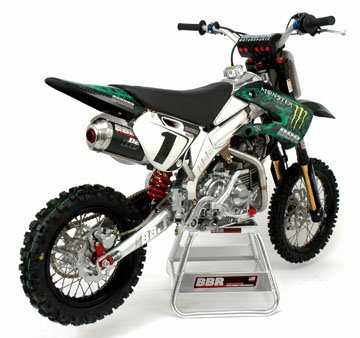 Hopefully, it is obvious that building a championship bike is more than sitting on the dyno trying to squeeze out peak horsepower. Of course, we have an in-house dyno, but peak horsepower doesn't win races. BBR's specialty has always been building a great package. Innovative frame design, works quality suspension and brakes, and engine development that delivers usable power. Thanks to the hard work of everybody at BBR, it all paid off with Derek being the first person ever to win both classes at MiniMoto SX.
Hopefully, it is obvious that building a championship bike is more than sitting on the dyno trying to squeeze out peak horsepower. Of course, we have an in-house dyno, but peak horsepower doesn't win races. BBR's specialty has always been building a great package. Innovative frame design, works quality suspension and brakes, and engine development that delivers usable power. Thanks to the hard work of everybody at BBR, it all paid off with Derek being the first person ever to win both classes at MiniMoto SX.
Question of the Week
"What is the fix for the front brake on my Marzocchis? They drag all the time and almost stop the front wheel in the air. Plus they’re next to impossible to bleed." - Daniel
Hey Daniel; we gave up on the Formula brake a long time ago. It is basically a mountain bike brake. The worst part is they use a non-floating caliper, so as the brake pads wear, the brake drags even more. The other thing is that if the rotor gets bent it just drags on itself. And you have to be a genius to bleed these things. You’re going to end up bleeding yourself before it is over. Take them off and put them in the circular file, because we have you covered. Chris came up with a mini CR style full-floating brake a couple of years ago that gives you big bike performance and feel. It even uses your favorite "big bike" CR brake lever. It works with the stock Marzocchi hub or we have a trick billet aluminum hub that will spoke into stock style rims (in colors!). Also, Galfer provides a tough wave rotor for this setup. Click here for the 110 brake, and here for the 50 brake. Hope this helps. As always feel free to give us a ring anytime. We love to talk motorcycles!
Blast from the Past
This week's blast from the past is from the January 2005 Dirt Rider Magazine and our buddies over there (Jimmy Lewis, Karl Kramer, Dick Burlson and the whole crew). At that time, the mini bike scene was exploding so the largest off road magazine decided to put a mini-bike on the cover. This was also Jimmy Lewis’ first issue with Dirt Rider as Editor. Being the mini-bike nut that he is, he called looking for the ultimate mini-bike. Ricky Carmichael had just switched to Suzuki so we were in the middle of building his personal 110's when we got the call. It was Jimmy’s lucky day. At the time there were very few parts for the 110. The biggest bore kit available was a 130. We knew that wasn’t going to be enough for RC, so we took a 150F Honda piston and started machining it to come up with the first 160cc kit. Chris Gosselaar would use a version of this kit and bike to win MiniMoto 2005.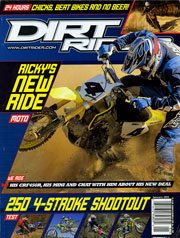
OK that’s it for this week. Thanks for helping us live the dream!
Duane
